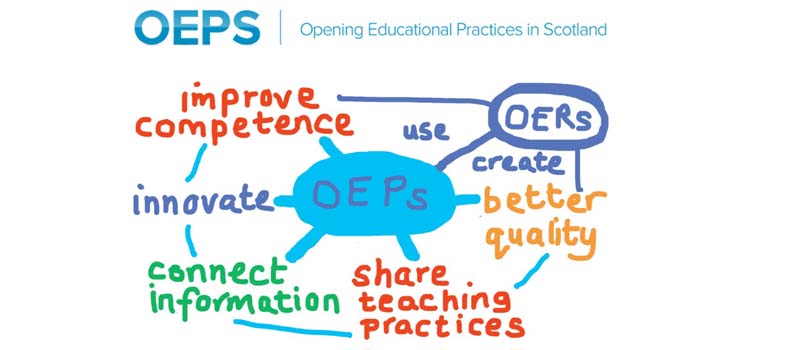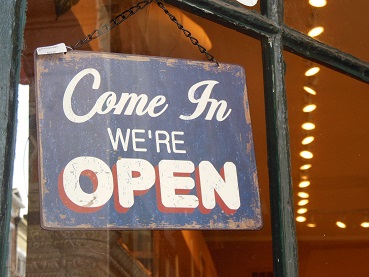1.3 Open educational resources and open educational practices?
Having thought a bit more about what ‘open’ means, let's now take a closer look at what is meant by practices and resources that are ‘open’. To start with, let’s focus on a particular kind of resource that will help us make sense of openness in practice: open educational resources (OER).
Educational resources are anything you use to help with your teaching or learning. A video you’ve used in class, a lesson plan, a register, a presentation, a textbook or chapter from a book or a model that you use to illustrate an example … the list is endless!
You might have looked for resources online or in the library to accompany your lessons or a presentation. You might have used an online video or found an image which helps illustrate a point you want to make. Maybe you have searched TES Resources or BBC Bitesize for inspiration when planning your lessons. Often there are copyright restrictions on how you can use resources that you find, but within an educational context you are able to use these due to what is described as ‘fair dealing’ or ‘fair use’.
What makes an educational resource open?
An open educational resource (OER) is a resource that, because of the licence it has, gives you explicit information and permission to reuse the resource without needing to ask the content’s author. The permissions given via an open licence state how you can reuse the resource (e.g. whether the author just needs to be attributed, whether you cannot use it for commercial purposes or whether you can make changes to the material) and how you should attribute it. OER are not necessarily always digital, but those that are made available online, for example via repositories, also give users the ability to remix the resources in situ.
From an author’s perspective, releasing your material as an OER and not requiring potential users to seek your permission for reuse can lead to interesting outcomes. You can find out more about ‘what happened next’ in relation to a variety of OER in Alan Levine’s True Stories of Open Sharing.
However, let's first explore in a little more depth what is meant by an OER. Defining OER is important, as what is meant by ‘open’ within this context provides a good foundation for thinking about the things that you need to do when creating an OER and how this might change your own practice.
UNESCO defines Open Educational Resources as:
‘… any type of educational materials that are in the public domain or introduced with an open licence. The nature of these open materials means that anyone can legally and freely copy, use, adapt and re-share them. OER range from textbooks to curricula, syllabi, lecture notes, assignments, tests, projects, audio, video and animation.’
Another way of thinking about what makes an educational resource ‘open’ is to think about what an ‘open’ resource enables you to do with its content/material. David Wiley, a well-known open education advocate describes OER as enabling you to do five things with material: Retain, Reuse, Revise, Remix, and Redistribute. These are also known as the ‘5 Rs’. According to Wiley, facilitating all of the ‘Rs’ enables an educational resource to be described as ‘open’. There are certain considerations that need to be taken into account to make this happen, and these are discussed in more detail later on in the course.
As you can see, just like copyrighted educational resources, OER can be all kinds of different materials you might use in your teaching or learning. OER can be both online and offline and in all kind of formats: many YouTube videos, presentations on Slideshare or photos on Flickr are often openly licensed, whilst whole textbooks in a range of subjects are often openly available (these are called ‘open textbooks’).
Open education
The idea of ‘opening up’, or giving greater access to educational opportunities, is not a new one. Removing barriers to knowledge and increasing access (the process of ‘democratising knowledge’) can be traced back to the development of the printing press, for example prior to compulsory education being introduced in the late 19th Century (1880 in England and Wales and 1872 in Scotland), philanthropic and charitable endeavours provided educational opportunities to working class children in the form of Ragged Schools and other initiatives.
The term ‘OER’ came into common usage in the early 2000s and has received support from many different individuals and organisations. Read about the types of commitments made by different organisations and individuals in the Cape Town Open Education Declaration from 2007 and the 2012 Paris OER Declaration. The Scottish Open Education Declaration of 2013 broadened the scope of the Paris OER Declaration by focusing on education as a whole.
You might be familiar with the open source movement, which was a forerunner of the OER movement. Open source means that code, software and tools are openly available so that people can improve and build on others’ work, as well as access the tools and software for no cost at the point of use. Examples include Moodle, Drupal, Ubuntu and Linux.
This ethos of community, sharing, increased access and collaboration underpins the open education movement and can be described as an ‘open educational practice’.
What does it mean for an educational practice be ‘open’?
As a range of different practices could be described as ‘open’ and support the use of OER, there is no definitive definition of open educational practices (OEP). However, looking closer at two working definitions of OEP will assist in understanding the difference between OER (open resources of a particular type) and OEP (which is more focused on the context and action to engender the use of OER and the outcomes from doing so).
Building on Conole’s (2010) definition of OEP as ‘…the set of activities and support around the creation, use and repurposing of Open Educational Resources’ and the associated ‘contextual’ dimensions of this, Ehlers and Conole (2010) developed a definition of OEP to reflect both the collaborative aspects of open practice and the reasons why all kinds of people might use OER:
‘Open Educational Practices (OEP) are the use of open educational resources with the aim to improve the quality of educational processes and innovate educational environments.’
Other definitions of OEP are broader and emphasise the social justice elements of openness. For example, the working definition used by the Opening Educational Practices in Scotland project:
We think of Open Educational Practices as those educational practices that are concerned with and promote equity and openness. Our understanding of ‘open’ builds on the freedoms associated with ‘the 5 Rs’ of OER, promoting a broader sense of open, emphasising social justice, and developing practices that open up opportunities for those distanced from education.
Open education as ‘disruptive’?
Discussion on the rapid ascendency Massive Open Online Courses (MOOCs) such as Coursera, edX and FutureLearn over the past few years has often been framed within the context of their potential impact on formal education and the narrative of disruption. The idea of ‘disruptive innovation’ originates from Bower and Christensen (1995), and you can read more about this in relation to MOOCs and open education in the JISC CETIS publication MOOCs and Open Education: Implications for Higher Education. Christensen, Raynor and McDonald (2015) revisit and clarify the idea of disruption in ‘What is disruptive innovation?’.
In responding to such claims about the impact of MOOCs there has also been discussion about how ‘open’ such resources are and determining what the difference is between OER and MOOCs. In answer to the latter question, an OER can, for example, refer to any type of open resource, not just a course. However the ‘openness’ of MOOCs in particular is often in question and MOOCs are often perceived as having a slightly different conception of ‘openness’ than that exemplified by Wiley’s ‘5Rs’. For example, whilst being free to take course or access a resource, you might only be able to view the materials if you sign up. Often MOOC content is not openly licensed, so you won’t be able to remix or reuse the materials used to make up the course.
Similarly, material might only be available for a limited time between the start and end dates of the MOOC and may not be released as OER afterwards. MOOCs are often acknowledged as being ‘open enrolment’ but they may not necessarily be open in terms of their content. However, there are exceptions, for example the Open University’s FutureLearn MOOCs are released on OpenLearn after their final presentation as perpetually open courses (see for example Introduction to cyber security).
Activity 1B
Before moving on to look at open licences and openness in a little more detail, let’s take a few minutes to explore some explanations of what open educational resources are and why open matters. There are a selection of descriptions and videos to choose from in Section 1.6, but to get started watch the short video ‘The OERs – open educational resources’ – you can watch it below or open it in a new window or tab in your web browser.
Transcript
For the longest time human societies evolved very slowly but since not so long ago our pace of change has been increasing exponentially, ever faster and faster and faster and faster and faster and a lot faster. This constant evolution is only possible through the production and assimilation of knowledge and a system transmitting it from generation to generation.
The most efficient system we have come up with so far is formal education a process whose pinnacle of achievement is a degree from a top university. The education given at these institutions opens a huge window of opportunities as students learn from the highest qualified professors and acquire the most cutting edge knowledge available. But the system as it is cannot deliver this knowledge to everyone, it is by nature exclusive. Now imagine that this were to change, how would our world be if everyone could benefit from the opportunities offered by studying at these institutions?
Well this is already happening. Some of the best universities in the US are openly sharing their courses online and this is just part of a trend, the trend of open educational resources. OERs are revolutionary technologies of knowledge delivery that use the internet to share and spread educational content making high quality education available for each motivated person to access for free. Opening access to top university courses is just one of the many things OERs can do. They can also serve as the best high school tutor guiding you through thousands of topics with interactive exercises. They make up what may be the biggest textbook library in the world and provide the best tailored way to improve and broaden your professional skills at your own pace. OERs are creating a new system of education, one which is better adapted to respond to our highly dynamic economy. Equal access to knowledge means equal opportunities in life and in a world with equal opportunities it all depends on you. Now that's the meaning of freedom.
Now use your reflective log to write down your thoughts about your own context and what kinds of resources could be open. Why might it be important to have educational resources that are open?
1.2 What does ‘open’ mean?

